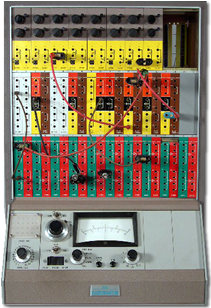| |

This collection of rare and vintage computers is one of the largest collections of historical computers in the United States.
The EarlyComputers' collection is intended to foster education, encourage research and preserve items that are an integral part of computer history.
Our goal is to provide a wide array of rare materials (hardware, software, magazines, newsletters, peripheral devices,
books, advertisements, games and personal recollections) that can be used to obtain a broader and better
understanding of the history of computing.
The collection houses over 1,000 vintage
computer related items, including more than 180 vintage computers and over 20 analog computers. The collection of hardware, software and print materials
consists of a wide variety of rare computer items ranging from an 1834 article about Charles Babbage's "new Calculating Engine"
to a 45 rpm blue, vinyl record used to store computer
programs to numerous computers manufactured between 1950 and 1981.
The EarlyComputers website is attempting to provide you with original research using primary source materials whenever possible.
Aside from making use of the rare computers in the EarlyComputer's collection, we are also making use of the Smithsonian,
the National Archives,
numerous other collections (such as Bruce Damer's DigiBarn collection) and personal interviews with individuals who were involved in bringing about the
personal computer revolution.
What's in the EarlyComputers Collection?
- The collection houses personal computers such as Altair, Imsai, Nascom, Cromemco, OSI,
SWTPC, AIM, Cosmac, Hewitt-Packard, Minivac, Commodore, Heathkit, Intel, EAI, Olivetti, Northstar, CompuKit and Texas
Instruments among others. (see a partial listing on the right)
- We house a very large collection of rare computer documents related to the history of
computing. These include documents from early as 1834 (Charles Babbage's Difference Engine),
1889 (the Electric Tabulating System), 1948 (Shannon's Mathematical Theory of Communication), 1949 (Shannon's
Communication Theory of Secrecy Systems), 1965 (Gordon Moore's article in which he posits the now famous "Moore's Law")
and many others up to 1981.
- Another focus of the collection is on contemporary print material ranging from computer magazines
(such as the People's Computer Company, Byte and the Silicon Gulph Gazette) to company catalogs and brochures to mimeographed newsletters such as the Computer Notes (Altair), the Viper (Cosmac VIP) and Ipso Facto.
- In addition, the collection houses the largest collection of analog computers in North
America and includes analog computers from companies such as Electronic Associates Inc., Welch, Donner Scientific
and AMF among others. The collection includes several extremely rare analog computers such as the Pastoriza Personal Analog computer,
a pre-WWII US Navy fire control analog computer and the Lan-Electronics Analogue Computer (the English spelling).
- We also have a large number of rare computer documents and objects related to Herman Hollerith who
is the first person to use electricity in tabulating data. His Electric Tabulating Machine is one of the foundations
of modern computing and it clearly demonstrated that electrical computing would be significantly more efficient than any
other known method. Hollerith is also credited with developing the modern punch card system of storing and sorting
data (what many of us now call IBM cards).
|
The EarlyComputers' collection of vintage computers is currently housed near Philadelphia, Pennsylvania. But we have travelled far and wide
to find rare computers, obtain vintage documents and interview those who have
contributed to the history of computing. Among the places
we have travelled in our search for computer history are
|
- Bletchley Park, England
- Cardiff, Wales
- Panama City, Florida
- Olathe, Kansas
- Leicester, England
- London, England
- Massachusetts
- Milan, Italy
- Montreal, Canada
- Albany, New York
- Ohio (yes, we even went to Cleveland)
- Richmond, Virginia
- Rugby, England
- St. Lake City, Utah
- Sacremento, California
- San Jose, California
|
|
In addition to our travels, we have collected items from:
Australia
Austria
Brazil
Denmark
Egypt
France
Germany
India
Japan
Netherlands
Phillippines
Poland
|
What is a "Vintage Computer"?
There are many definitions of what an "early" computer really is. Some say a computer made more than 20 years ago is
historical, others argue that a truly vintage computer must be 25 years or even 30 years. The trouble with choosing
a timespan like "25 years ago" is that it changes as each year goes by.
We choose to pick a significant date in the history of personal computing.
We define early computers as those made before
IBM entered the personal computer market in 19811. IBM's entrance into
personal computing changed the face of the industry. With IBM's knowledge, marketing and
world-wide presence, it instantly became the 800 pound gorilla and
not many companies survived. Therefore, our collection is generally limited to
items manufactured or printed ON or BEFORE 1981.
For a more detailed definition of what makes a vintage computer, see our article entitled,
"What was the first personal computer?".
[Coming Soon]
As we develop the earlycomputers.com website, we hope to give you the opportunity to participate directly online....
the chance to add your stories, your research and your experience to ours. In the meantime, if you are interested
in participating, please contact us at help@earlycomputers.com.
|
COMPUTER COLLECTION
1926--1981
(Analogs are in blue)
- AIM-65 (single board)
- AIM-65 (factory case)
- AIM-65 (Jon Titus)
- ALICE micro-ordinateur
- Altair 680
- Altair 8800
- Altair 8800A
- Altair 8800b
- Altair 8800b Turnkey (see Pertec below)
- Altair 8800b (see Pertec below)
- Altair 8800b w/ Hardisk Controller & Datakeeper
- Altos ACS-8000
- American Basic Science Club Analog Computer
- AMF Educational Computer Model 665/C
- AMF Educational Computer Model 775 A
- Apple II Plus
- ASCI SystemX
- ASR 33 Teletype
- Analog Training Computer ATC-610 (EAI)
- Automatic Teaching Computer Kit
- Beckman ElectroComp Electric Heating Computer
- Beckman ElectroComp Energy Savings Computer
- Beckman Solid State Fuel Cost Computer
- Brainiac K-30
- Calif. Computer Systems 2200
- CES Ed-Lab 650
- Commodore 8032
- Commodore 64
- Commodore PET 2001
- Commodore Super Pet
- Compucolor II
- Compukit 1
- Compukit 1 Deluxe Model
- Compukit 2
- Compukit UK101
- Comspace CT-650
- Cosmac Elf (RCA1802)
- Cosmac Microtutor
- Cosmac Netronics ELF II
- Cosmac VIP
- Cromemco System I
- Cromemco System III
- Cromemco Z-2D
- Datapoint 2200
- Digi-Comp I (small flat box)
- Digi-Comp I (large flat box)
- Digi-Comp I (long box)
- Digi-Comp II
- Digital Computer Lab
- Donner 3500
- Durango F-85
- Dynabyte
- E & L Inst MMD-1
- E & L Inst MMD-2
- Eagle II
- Electric Tabulating Machine (one original counter, 1889)
- Electronic Associates TR-10
- Electronic Associates TR-10 Model II
- Electronic Associates TR-20
- Electronic Associates TR-48
- Electronic Associates Model 180
- Electronic Associates Model 380 Hybrid
- Geniac
- Google Glass (definitely not vintage)
- Heath EC-1 (factory assembled by Heath)
- Heathkit EC-1 (kit)
- Heathkit ET 3100 trainer
- Heathkit H8
- Heathkit H9 Video Terminal
- Hewlett Packard 2115A
- Hewlett Packard 85
- Hewlett Packard 5036A
- Hewlett Packard 9825A
- Hewlett Packard 9825B
- Hewlett Packard 9830A
- Hickok Logic Teaching Sys.
- Hickok Servo Teaching Sys.
- Iasis 7301
- I-COR MAC-1
- ICS Microcomputer Training System
- IMSAI 108 (prototype)
- IMSAI 8048 Control Computer
- IMSAI 8048 (The Dollhouse Computer)
- IMSAI 8080
- IMSAI PCS-40
- IMSAI PCS-80
- IMSAI VDP-80
- Informer
- Intel Intellec MDS
- Intel MDS-800
- Intel Prompt 48
- Intel SBC 80/10
- Intel SDK-85
- Intel SDK-85 (unassembled)
- Intel SDK-86
- Intertec Superbrain
- ITT MP-EX
- JR-01 Computer
- KIM-1
- LAN-DEC
- LAN-DEC 20
- LAN-ALOG
- Lehrcomputer (Germany)
- Lawrence Livermore Lab
- Lear Siegler ADM3A
- Logikit LK255 (Feedback)
- Logix SF-5000 Electronic Computer
- MAC-1 Mini Analog Computer
- MAC Tutor (Bell Laboratories)
- Mark 1A Fire Control Computer, ElectroMechanical Analog Computer, 1945?
- MEK6800D2
- Micro 68
- MicroAce
- Microtan 65
- Midwest Scientific Instruments 6800
- Minivac 601
- Minivac 6010
- Mini-Scamp Microcomputer
- Nascom I
- Nascom II
- National Radio Institute 832
- NEC TK-80
- NorthStar Horizon
- Olivetti Programma 101
- Olivetti Programma 203
- Olivetti Programma 602
- Open University PT501
- Ordinateur d'Apprentissage JR-01
- Osborne 1
- OSI 300
- OSI 600 (SuperBoard II)
- OSI C2-OEM-4
- OSI Challenger-1P
- Pastoriza Personal Analogue Computer
- Pertec MITS 300/25 (Altair desk business system)
- Pertec MITS 300/55 (Altair Turnkey business system)
- PolyMorphic Systems 8810
- PolyMorphic Poly-88
- Protech-83
- Range Keeper Mk.6 Mechanical Analog Computer, 1926
- Range Keeper Mk.7 Mechanical Analog Computer, 1934
- Sargent-Welch Scientific Company Cat. No.7528 Analog Computer
- Science of Cambridge MK-14 (Sinclair)
- SD Systems Z80 starter kit
- Sharp MZ-40K
- Sharp MZ-80k
- Siemens ECB-85
- Signetics Instructor 50
- Sinclair ZX-81
- Smoke Signal Broadcasting
- Sol-20
- Spark16
- Sphere 1
- Sphere/SWTPC Computer System
- SWTP CMOS Microlab
- SWTP CT-82 Terminal
- SWTPC 6800
- SWTPC 6800 (w/ Smoke Signal Broadcasting drive)
- SWTPC CT-64 Video Terminal, SS-50
- SWTPC TV Typewriter II CT-1024
- Synertek VIM-1
- Synertek SYM-1
- Systron-Donner 3500
- Tei MCS-112
- Tektronix 4006-1
- Telefunken RAT 700
- TI LCM-1001 (Microprogrammer)
- TI LCM-1001 (Microprogrammer)
- TI Silent 700 Terminal
- TI TM 990/189
- Vector 1
- Vector 3
- Vidac 336
- Wang 2200
- Welch Scientific Company Cat. No.7528 Analog Computer
- Xerox 820 Mark I
OTHER COMPUTERS (LUGGABLES 1982-1986)
- Chameleon Plus
- Commodore SX64
- Epson HX-20
- Hewlett Packard 110
- Kaypro I
- Kaypro II
- Kaypro 2x
- Kaypro 16
- Osborne 1
- Panasonic Senior Partner
- Visual Commuter
RARE & NOTABLE DOCUMENTS
- Babbage's Calculating Engine (1834)
- Electric Tabulating Machine (1889, Herman Hollerith's personal copy)
- The Hollerith Electric Tabulating System (1890)
- Counting a Nation by Electricity (1891)
- Calculating Machines (1947)
- Moore School Lectures Vol. II (1947)
- Mathematical Theory of Communication (1948)
- Communication Theory of Secrecy Systems (1949)
- The "Moore's Law" article (Electronics, 1965)
- Printout from Babbage's Difference Engine #2 (London Science Museum, 2004)
|
|



